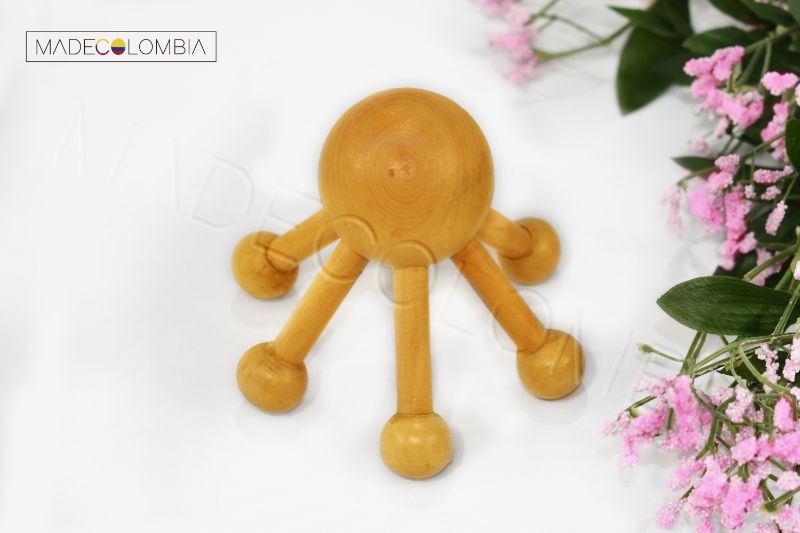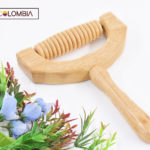The Art of Wooden Massage: Exploring Maderotherapy

Maderotherapy as an Art Dive into the history and art of Maderotherapy, an ancient technique that has endured through the centuries. This ancient method of healing and well-being has its roots in ancient cultures from around the world, where wood has been revered for its connection to nature and its powerful healing properties.
The origin of Maderotherapy dates back to ancient civilizations, where wise individuals recognized the intrinsic wisdom of wood and its ability to restore harmony to the body and mind. From ancient Egyptians to shamans in South America, different cultures have used wooden tools to address physical ailments and promote holistic health.
The art of Maderotherapy lies in the careful selection of wood and the creation of specially designed tools that can adapt to the curves and contours of the body. Each piece of wood, skillfully carved with love and expertise, becomes an extension of the therapist’s hands, transmitting their energy and knowledge through every movement.
Maderotherapy is a delicate and harmonious dance between the therapist and the recipient. Wood, with its smooth and warm texture, glides gracefully and precisely over the skin, releasing muscle tension and stimulating blood circulation. It is an art in which the therapist becomes a channel of healing, harnessing the power of wood to restore balance and vitality.
The beauty of Maderotherapy lies in its holistic approach, addressing not only the physical body but also the mind and spirit. When receiving a wooden massage, a sacred space is created where the recipient can disconnect from daily stress and immerse themselves in a deep state of relaxation and renewal.
The Benefits Offered by this Art Throughout the centuries, Maderotherapy has evolved and adapted to people’s needs and preferences. Today, this technique is combined with other therapeutic approaches, such as aromatherapy and traditional medicine, to offer an even more enriching experience.
Maderotherapy offers a wide range of benefits for the body, mind, and spirit. It promotes deep relaxation, releasing accumulated muscle tension and calming the mind. The gentle, rhythmic movements of wooden tools stimulate pressure points, generating an overall sense of well-being and releasing endorphins.
Furthermore, this technique enhances blood and lymphatic circulation. Massages with wooden tools stimulate blood flow and toxin elimination, contributing to healthier skin and a radiant appearance. By improving tissue oxygenation, benefits are achieved in skin quality.
One of the most notable benefits of Maderotherapy is its ability to tone and firm the body. Specific movements and techniques help stimulate muscles, promoting collagen and elastin production. This contributes to a firmer and toned appearance, especially in areas such as the buttocks, thighs, and abdomen.
Maderotherapy is also effective in body shaping. It stimulates circulation, breaks down fat deposits, and improves skin texture. This can provide visible and lasting results, allowing for a smoother and more sculpted appearance.
In addition to aesthetic benefits, Maderotherapy can alleviate muscle and joint pain. Kneading, friction, and sliding movements with wooden tools help relax tense muscles, reduce inflammation, and alleviate pain.
Another significant benefit is the stimulation of the lymphatic system. Maderotherapy activates the lymphatic system, improving toxin elimination and reducing fluid retention. This contributes to internal detoxification, promoting overall health and well-being.
Finally, Maderotherapy has a positive effect on mood and stress reduction. Massages with wooden tools have a relaxing effect on the nervous system, which can help reduce anxiety, stress, and improve mood. Additionally, it provides a space for self-care and self-connection, generating a sense of balance and emotional well-being.
Maderotherapy for Cellulite Yes, Maderotherapy can be beneficial in reducing the appearance of cellulite. Cellulite is a common condition in which fat deposits accumulate beneath the skin, causing dimples and an uneven appearance in areas such as the thighs, hips, and buttocks.
Maderotherapy uses specially designed wooden tools to address cellulite and improve skin texture. During a Maderotherapy session, specific kneading, friction, and sliding movements are applied to the affected areas. These movements stimulate blood and lymphatic circulation, helping to break down fat deposits, eliminate toxins, and improve the appearance of the skin.
Furthermore, massages with wooden tools contribute to toning tissues and strengthening muscles, which can help smooth the skin’s surface and reduce the appearance of cellulite.
It’s important to note that Maderotherapy is not a miracle treatment, and results may vary from person to person. The regularity of sessions, combined with other healthy habits such as a balanced diet and regular exercise, and consultation with a qualified Maderotherapy professional, can influence the results obtained.
In general, Maderotherapy can be an effective and natural option for addressing cellulite, promoting a smoother and toned appearance of the skin. If you’re interested in treating cellulite, I would recommend seeking out a qualified Maderotherapy therapist and discussing your goals and expectations to receive the best personalized approach for you.
Contraindications of Maderotherapy Although Maderotherapy is generally safe and non-invasive, there are some contraindications to consider. It’s essential to consult with a qualified Maderotherapy professional to assess your individual situation before undergoing this technique. Here are some common contraindications:
- Pregnancy: During pregnancy, Maderotherapy treatments should be avoided as they can stimulate circulation and potentially affect the fetus. It’s important to consult with your doctor or healthcare professional before undergoing any type of therapy during pregnancy.
- Skin Conditions: If you have any skin conditions such as dermatitis, psoriasis, or active skin infections, it is recommended to avoid Maderotherapy in the affected areas. Massage with wooden tools can irritate or worsen these conditions.
- Circulatory Issues: If you have severe circulatory disorders, such as deep vein thrombosis or advanced peripheral artery disease, Maderotherapy should be avoided. Vigorous movements can affect circulation and worsen the condition.
- Acute Muscular or Joint Problems: If you have acute muscle or joint injuries or inflammation, it is advisable to avoid Maderotherapy until the condition has improved. Massage with wooden tools can be too intense and exacerbate the injury.
- Serious Illnesses: In case of serious illnesses such as cancer, cardiovascular diseases, or disorders of the nervous system, permission from a doctor is required before undergoing Maderotherapy. It’s important to consider any pre-existing health condition and ensure that Maderotherapy is safe and suitable for you.
Remember that this list is not exhaustive, and each person is unique, so it’s essential to consult a healthcare professional before undergoing any treatment. A qualified Maderotherapy therapist can assess your individual conditions and determine if Maderotherapy is suitable for you.
Related posts
Transform Your Well-being with Maderotherapy: Discover Its Benefits
Reshape Your Figure: How Maderotherapy Can Help You Achieve It
Maderotherapy: The Ancient Secret to Radiant Skin
Millennial Therapy: Everything You Need to Know About Maderotherapy
The Art of Wooden Massage: Exploring Maderotherapy
Are you interested
in wholesaling?












